1998 ISUZU TROOPER check engine
[x] Cancel search: check enginePage 887 of 3573
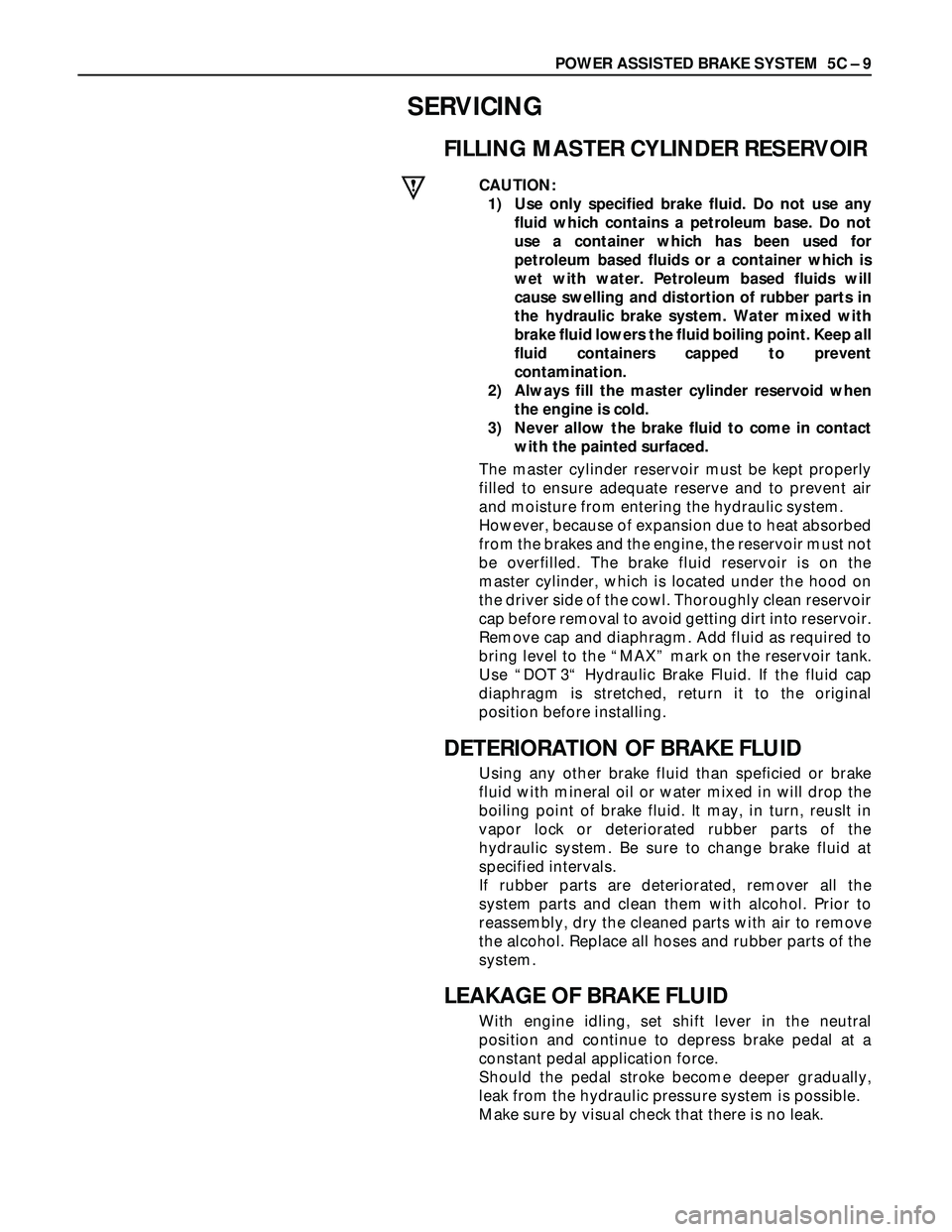
POWER ASSISTED BRAKE SYSTEM 5C – 9
SERVICING
FILLING MASTER CYLINDER RESERVOIR
CAUTION:
1) Use only specified brake fluid. Do not use any
fluid which contains a petroleum base. Do not
use a container which has been used for
petroleum based fluids or a container which is
wet with water. Petroleum based fluids will
cause swelling and distortion of rubber parts in
the hydraulic brake system. Water mixed with
brake fluid lowers the fluid boiling point. Keep all
fluid containers capped to prevent
contamination.
2) Always fill the master cylinder reservoid when
the engine is cold.
3) Never allow the brake fluid to come in contact
with the painted surfaced.
The master cylinder reservoir must be kept properly
filled to ensure adequate reserve and to prevent air
and moisture from entering the hydraulic system.
However, because of expansion due to heat absorbed
from the brakes and the engine, the reservoir must not
be overfilled. The brake fluid reservoir is on the
master cylinder, which is located under the hood on
the driver side of the cowl. Thoroughly clean reservoir
cap before removal to avoid getting dirt into reservoir.
Remove cap and diaphragm. Add fluid as required to
bring level to the “MAX” mark on the reservoir tank.
Use “DOT 3“ Hydraulic Brake Fluid. If the fluid cap
diaphragm is stretched, return it to the original
position before installing.
DETERIORATION OF BRAKE FLUID
Using any other brake fluid than speficied or brake
fluid with mineral oil or water mixed in will drop the
boiling point of brake fluid. It may, in turn, reuslt in
vapor lock or deteriorated rubber parts of the
hydraulic system. Be sure to change brake fluid at
specified intervals.
If rubber parts are deteriorated, remover all the
system parts and clean them with alcohol. Prior to
reassembly, dry the cleaned parts with air to remove
the alcohol. Replace all hoses and rubber parts of the
system.
LEAKAGE OF BRAKE FLUID
With engine idling, set shift lever in the neutral
position and continue to depress brake pedal at a
constant pedal application force.
Should the pedal stroke become deeper gradually,
leak from the hydraulic pressure system is possible.
Make sure by visual check that there is no leak.
Page 888 of 3573
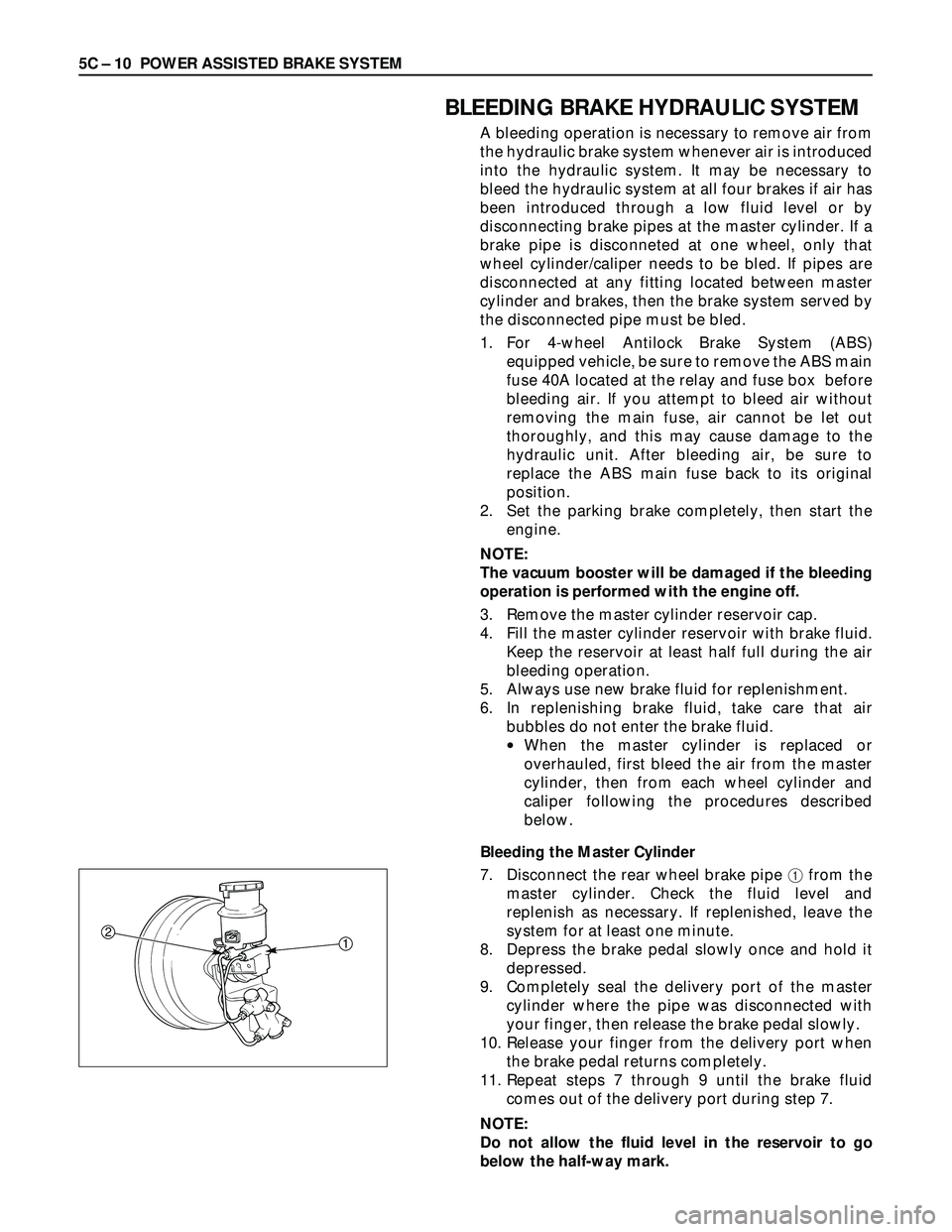
5C – 10 POWER ASSISTED BRAKE SYSTEM
BLEEDING BRAKE HYDRAULIC SYSTEM
A bleeding operation is necessary to remove air from
the hydraulic brake system whenever air is introduced
into the hydraulic system. It may be necessary to
bleed the hydraulic system at all four brakes if air has
been introduced through a low fluid level or by
disconnecting brake pipes at the master cylinder. If a
brake pipe is disconneted at one wheel, only that
wheel cylinder/caliper needs to be bled. If pipes are
disconnected at any fitting located between master
cylinder and brakes, then the brake system served by
the disconnected pipe must be bled.
1. For 4-wheel Antilock Brake System (ABS)
equipped vehicle, be sure to remove the ABS main
fuse 40A located at the relay and fuse box before
bleeding air. If you attempt to bleed air without
removing the main fuse, air cannot be let out
thoroughly, and this may cause damage to the
hydraulic unit. After bleeding air, be sure to
replace the ABS main fuse back to its original
position.
2. Set the parking brake completely, then start the
engine.
NOTE:
The vacuum booster will be damaged if the bleeding
operation is performed with the engine off.
3. Remove the master cylinder reservoir cap.
4. Fill the master cylinder reservoir with brake fluid.
Keep the reservoir at least half full during the air
bleeding operation.
5. Always use new brake fluid for replenishment.
6. In replenishing brake fluid, take care that air
bubbles do not enter the brake fluid.
•When the master cylinder is replaced or
overhauled, first bleed the air from the master
cylinder, then from each wheel cylinder and
caliper following the procedures described
below.
Bleeding the Master Cylinder
7. Disconnect the rear wheel brake pipe 1from the
master cylinder. Check the fluid level and
replenish as necessary. If replenished, leave the
system for at least one minute.
8. Depress the brake pedal slowly once and hold it
depressed.
9. Completely seal the delivery port of the master
cylinder where the pipe was disconnected with
your finger, then release the brake pedal slowly.
10. Release your finger from the delivery port when
the brake pedal returns completely.
11. Repeat steps 7 through 9 until the brake fluid
comes out of the delivery port during step 7.
NOTE:
Do not allow the fluid level in the reservoir to go
below the half-way mark.
21
Page 890 of 3573
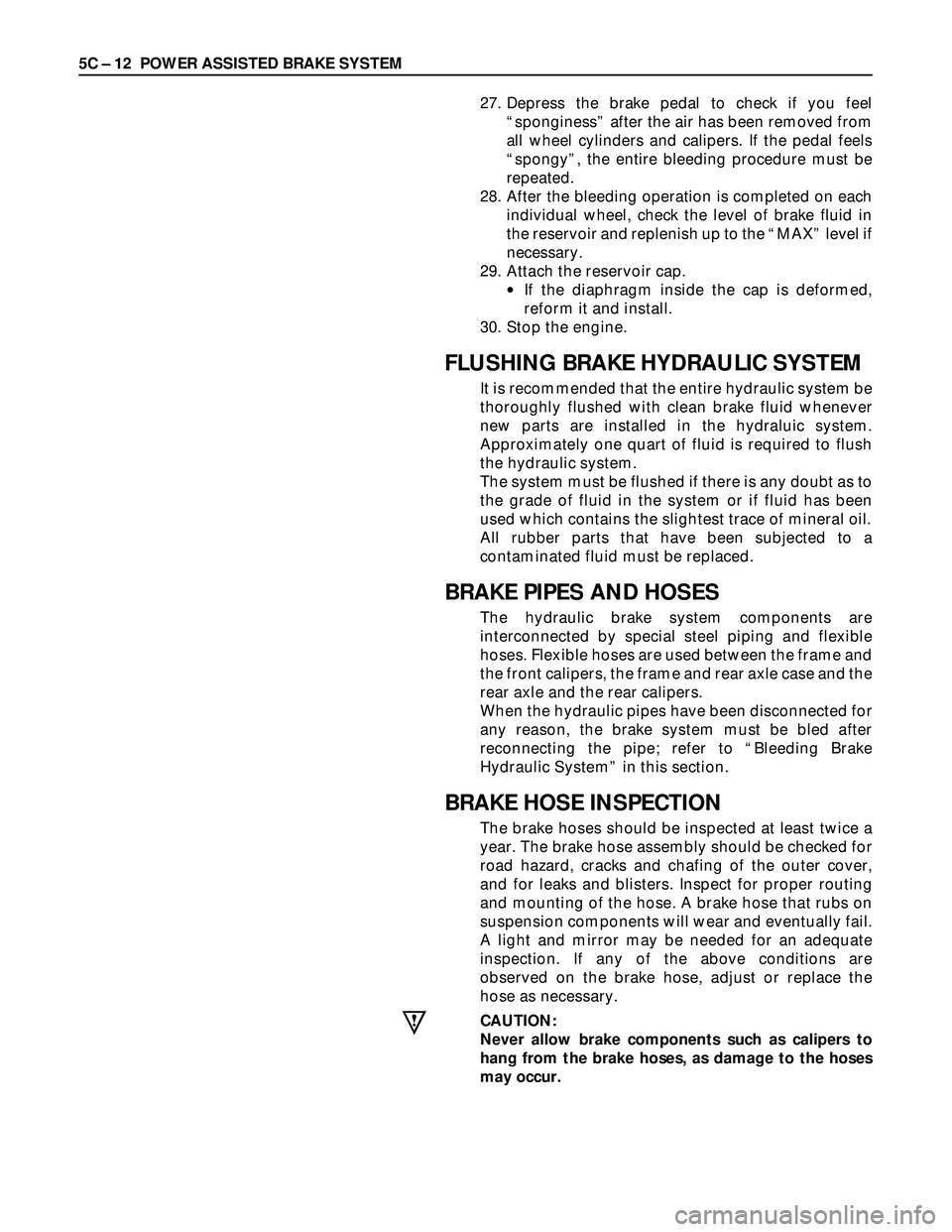
5C – 12 POWER ASSISTED BRAKE SYSTEM
27. Depress the brake pedal to check if you feel
“sponginess” after the air has been removed from
all wheel cylinders and calipers. If the pedal feels
“spongy”, the entire bleeding procedure must be
repeated.
28. After the bleeding operation is completed on each
individual wheel, check the level of brake fluid in
the reservoir and replenish up to the “MAX” level if
necessary.
29. Attach the reservoir cap.
•If the diaphragm inside the cap is deformed,
reform it and install.
30. Stop the engine.
FLUSHING BRAKE HYDRAULIC SYSTEM
It is recommended that the entire hydraulic system be
thoroughly flushed with clean brake fluid whenever
new parts are installed in the hydraluic system.
Approximately one quart of fluid is required to flush
the hydraulic system.
The system must be flushed if there is any doubt as to
the grade of fluid in the system or if fluid has been
used which contains the slightest trace of mineral oil.
All rubber parts that have been subjected to a
contaminated fluid must be replaced.
BRAKE PIPES AND HOSES
The hydraulic brake system components are
interconnected by special steel piping and flexible
hoses. Flexible hoses are used between the frame and
the front calipers, the frame and rear axle case and the
rear axle and the rear calipers.
When the hydraulic pipes have been disconnected for
any reason, the brake system must be bled after
reconnecting the pipe; refer to “Bleeding Brake
Hydraulic System” in this section.
BRAKE HOSE INSPECTION
The brake hoses should be inspected at least twice a
year. The brake hose assembly should be checked for
road hazard, cracks and chafing of the outer cover,
and for leaks and blisters. Inspect for proper routing
and mounting of the hose. A brake hose that rubs on
suspension components will wear and eventually fail.
A light and mirror may be needed for an adequate
inspection. If any of the above conditions are
observed on the brake hose, adjust or replace the
hose as necessary.
CAUTION:
Never allow brake components such as calipers to
hang from the brake hoses, as damage to the hoses
may occur.
Page 891 of 3573
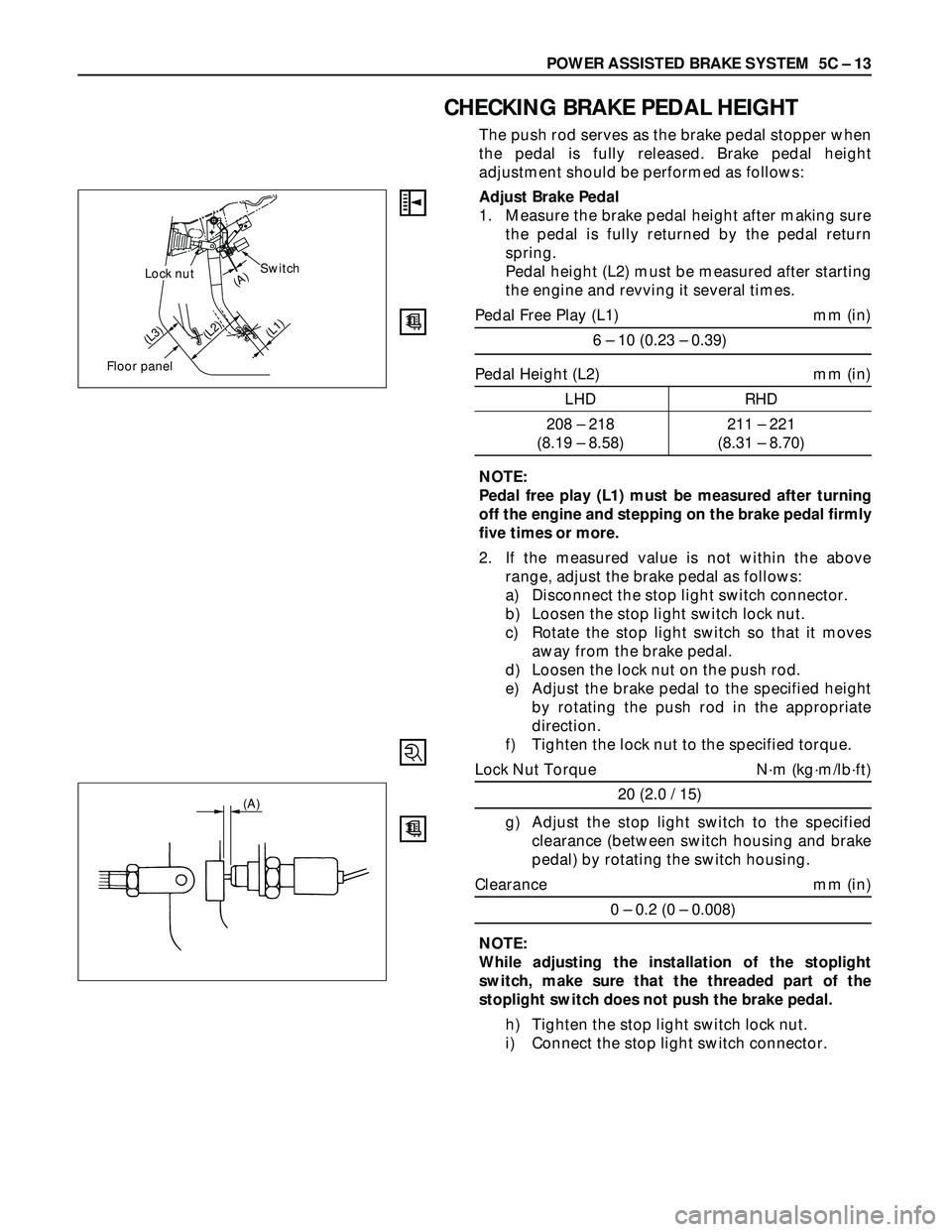
POWER ASSISTED BRAKE SYSTEM 5C – 13
CHECKING BRAKE PEDAL HEIGHT
The push rod serves as the brake pedal stopper when
the pedal is fully released. Brake pedal height
adjustment should be performed as follows:
Adjust Brake Pedal
1. Measure the brake pedal height after making sure
the pedal is fully returned by the pedal return
spring.
Pedal height (L2) must be measured after starting
the engine and revving it several times.
Pedal Free Play (L1) mm (in)
6 – 10 (0.23 – 0.39)
Pedal Height (L2) mm (in)
LHD RHD
208 – 218 211 – 221
(8.19 – 8.58) (8.31 – 8.70)
NOTE:
Pedal free play (L1) must be measured after turning
off the engine and stepping on the brake pedal firmly
five times or more.
2. If the measured value is not within the above
range, adjust the brake pedal as follows:
a) Disconnect the stop light switch connector.
b) Loosen the stop light switch lock nut.
c) Rotate the stop light switch so that it moves
away from the brake pedal.
d) Loosen the lock nut on the push rod.
e) Adjust the brake pedal to the specified height
by rotating the push rod in the appropriate
direction.
f) Tighten the lock nut to the specified torque.
Lock Nut Torque N·m (kg·m/lb·ft)
20 (2.0 / 15)
g) Adjust the stop light switch to the specified
clearance (between switch housing and brake
pedal) by rotating the switch housing.
Clearance mm (in)
0 – 0.2 (0 – 0.008)
NOTE:
While adjusting the installation of the stoplight
switch, make sure that the threaded part of the
stoplight switch does not push the brake pedal.
h) Tighten the stop light switch lock nut.
i) Connect the stop light switch connector.
Switch
Floor panel
(L3)
(A)
(L2)(L1)
Lock nut
(A)
Page 892 of 3573
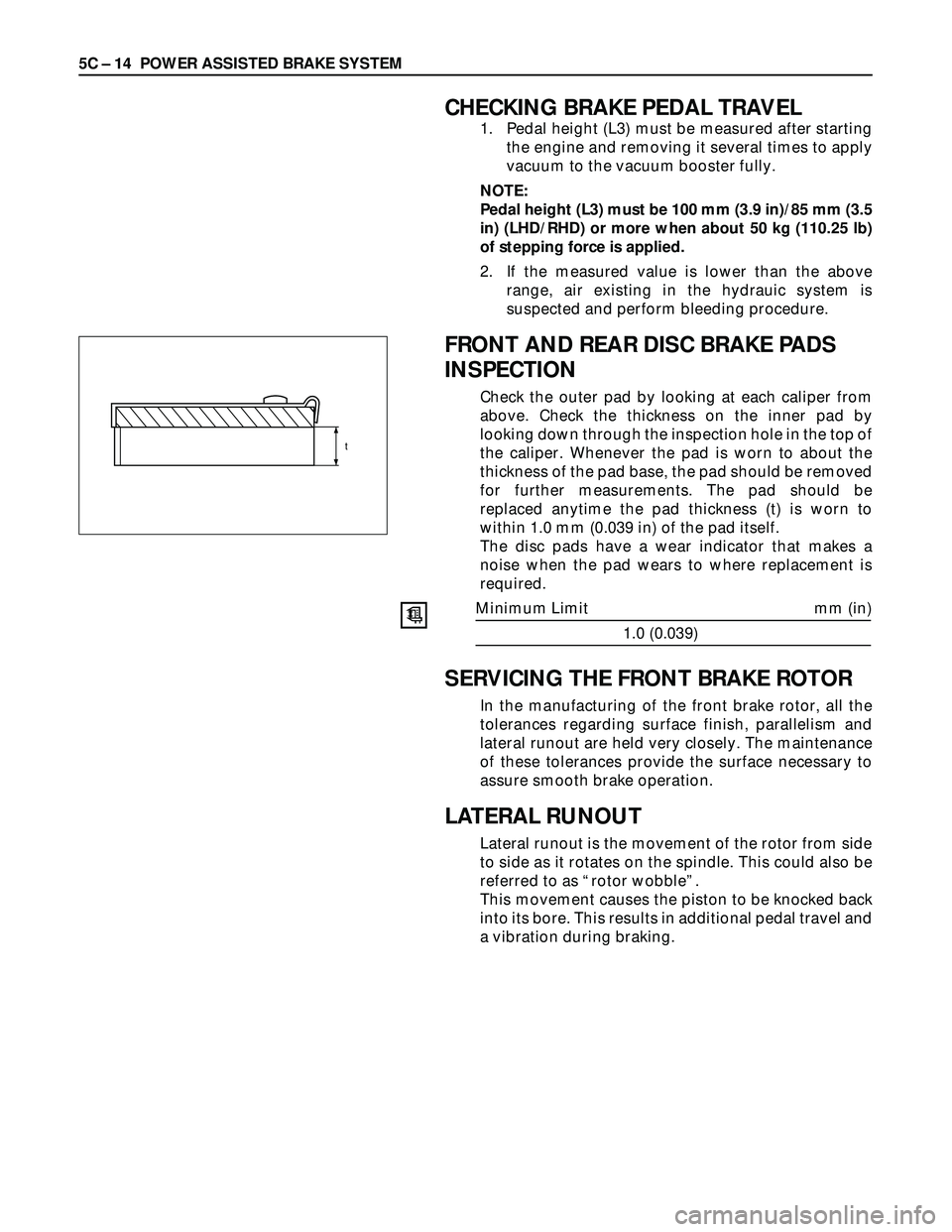
5C – 14 POWER ASSISTED BRAKE SYSTEM
CHECKING BRAKE PEDAL TRAVEL
1. Pedal height (L3) must be measured after starting
the engine and removing it several times to apply
vacuum to the vacuum booster fully.
NOTE:
Pedal height (L3) must be 100 mm (3.9 in)/85 mm (3.5
in) (LHD/RHD) or more when about 50 kg (110.25 lb)
of stepping force is applied.
2. If the measured value is lower than the above
range, air existing in the hydrauic system is
suspected and perform bleeding procedure.
FRONT AND REAR DISC BRAKE PADS
INSPECTION
Check the outer pad by looking at each caliper from
above. Check the thickness on the inner pad by
looking down through the inspection hole in the top of
the caliper. Whenever the pad is worn to about the
thickness of the pad base, the pad should be removed
for further measurements. The pad should be
replaced anytime the pad thickness (t) is worn to
within 1.0 mm (0.039 in) of the pad itself.
The disc pads have a wear indicator that makes a
noise when the pad wears to where replacement is
required.
Minimum Limit mm (in)
1.0 (0.039)
SERVICING THE FRONT BRAKE ROTOR
In the manufacturing of the front brake rotor, all the
tolerances regarding surface finish, parallelism and
lateral runout are held very closely. The maintenance
of these tolerances provide the surface necessary to
assure smooth brake operation.
LATERAL RUNOUT
Lateral runout is the movement of the rotor from side
to side as it rotates on the spindle. This could also be
referred to as “rotor wobble”.
This movement causes the piston to be knocked back
into its bore. This results in additional pedal travel and
a vibration during braking.
t
Page 901 of 3573

POWER ASSISTED BRAKE SYSTEM 5C – 23
VACUUM BOOSTER
This booster is a tandem vacuum unit with a diaphragm effective diameter 205 mm + 230 mm (gasoline
engine model) / 180 mm + 205 mm (diesel engine model). In normal operating mode, with the service
brakes in the released position, the tandem vacuum booster operates with vacuum on both sides of its
diaphragms. When the brakes are applied, air at atmospheric pressure is admitted to one side of each
diaphragm to provide the power assist. When the service brake is released, the atmospheric air is shut
off from the one side of each diaphragm. The air is then drawn from the booster through the vacuum
check valve to the vacuum source.
CAUTION:
1) If any hydraulic component is removed or disconnected, it may be necessary to bleed all or part of
the brake system.
2) The torque values specified are for dry, unlubricated fasteners.
3) The vacuum booster is not repairable and must be replaced as complete assembly.
Page 920 of 3573
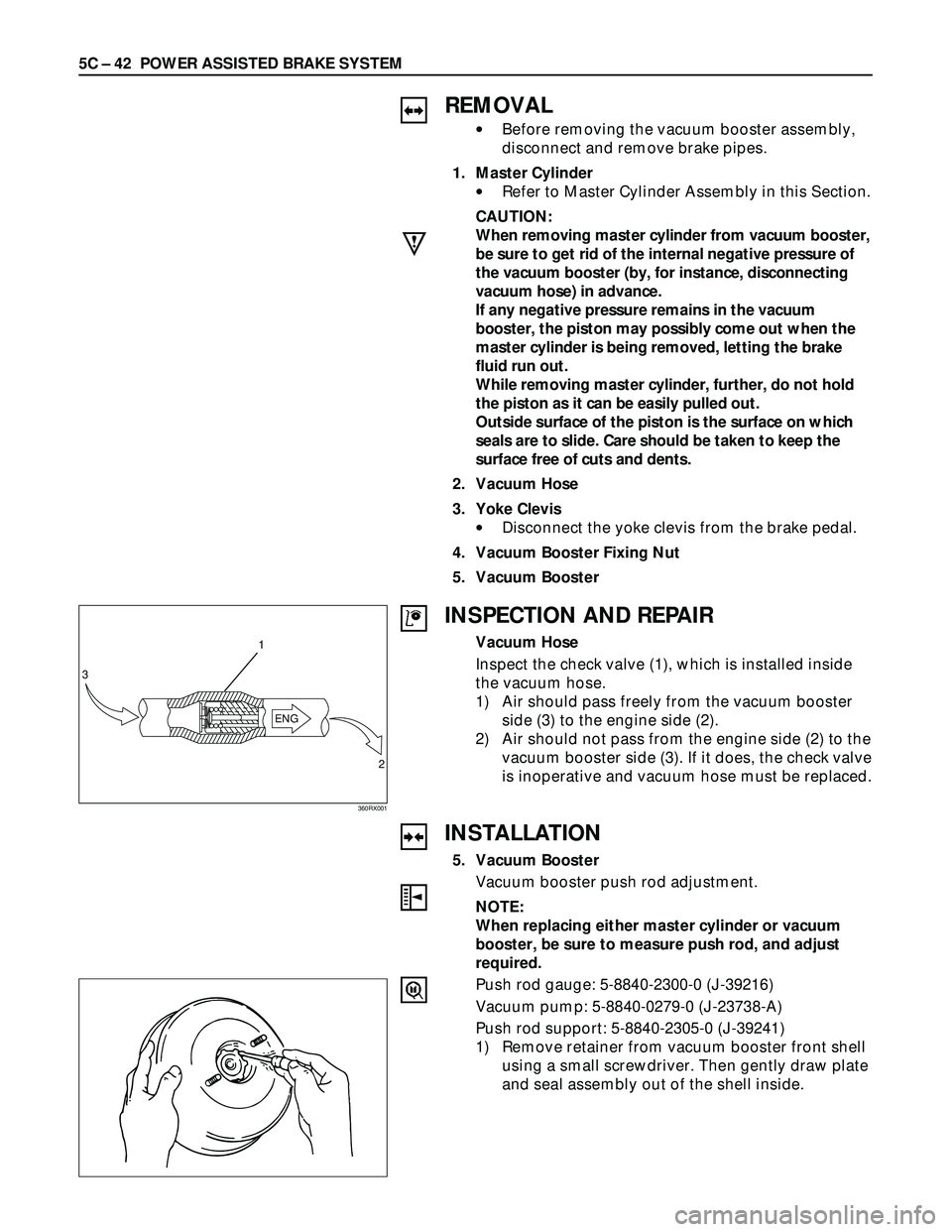
5C – 42 POWER ASSISTED BRAKE SYSTEM
REMOVAL
•Before removing the vacuum booster assembly,
disconnect and remove brake pipes.
1. Master Cylinder
•Refer to Master Cylinder Assembly in this Section.
CAUTION:
When removing master cylinder from vacuum booster,
be sure to get rid of the internal negative pressure of
the vacuum booster (by, for instance, disconnecting
vacuum hose) in advance.
If any negative pressure remains in the vacuum
booster, the piston may possibly come out when the
master cylinder is being removed, letting the brake
fluid run out.
While removing master cylinder, further, do not hold
the piston as it can be easily pulled out.
Outside surface of the piston is the surface on which
seals are to slide. Care should be taken to keep the
surface free of cuts and dents.
2. Vacuum Hose
3. Yoke Clevis
•Disconnect the yoke clevis from the brake pedal.
4. Vacuum Booster Fixing Nut
5. Vacuum Booster
INSPECTION AND REPAIR
Vacuum Hose
Inspect the check valve (1), which is installed inside
the vacuum hose.
1) Air should pass freely from the vacuum booster
side (3) to the engine side (2).
2) Air should not pass from the engine side (2) to the
vacuum booster side (3). If it does, the check valve
is inoperative and vacuum hose must be replaced.
INSTALLATION
5. Vacuum Booster
Vacuum booster push rod adjustment.
NOTE:
When replacing either master cylinder or vacuum
booster, be sure to measure push rod, and adjust
required.
Push rod gauge: 5-8840-2300-0 (J-39216)
Vacuum pump: 5-8840-0279-0 (J-23738-A)
Push rod support: 5-8840-2305-0 (J-39241)
1) Remove retainer from vacuum booster front shell
using a small screwdriver. Then gently draw plate
and seal assembly out of the shell inside.
ENG
1
2 3
360RX001
Page 960 of 3573

6A±4
ENGINE MECHANICAL
Engine Diagnosis
Hard Starting
1. Starting Motor Does Not Turn Over
Troubleshooting Procedure
Turn on headlights and starter switch.
Condition
Possible causeCorrection
Headlights go out or dim
considerably
Battery run down or under chargedRecharge or replace battery
considerablyTerminals poorly connectedClean battery posts and terminals
and connect properly
Starting motor coil circuit shortedOverhaul or replace
Starting motor defectiveOverhaul or replace
2. Ignition Trouble Ð Starting Motor Turns Over But Engine Does Not Start
Spark Test
Disconnect an igniton coil from any spark plug. Connect
the spark plug tester 5±8840±0607±0, start the engine,
and check if a spark is generated in the spark plug tester.
Before starting the engine, make sure that the spark plugtester is properly grounded. To avoid electrical shock, do
not touch the part where insulation of the igniton coil is
broken while the engine is running.
Condition
Possible causeCorrection
Spark jumps across gapSpark plug defectiveClean, adjust spark gap or replace
Ignition timing incorrectRefer to Ignition System
Fuel not reaching fuel injector(s) or
engineRefer to item 3 (Trouble in fuel
system)
Valve timing incorrectAdjust
Engine lacks compressionRefer to item 4 (Engine lacks
compression)
No sparking takes placeIgnition coil disconnected or brokenConnect properly or replace
Electronic Ignition System with
moduleReplace
Poor connections in engine harnessCorrect
Powertrain Control Module cable
disconnected or defectiveCorrect or replace
3. Trouble In Fuel System
Condition
Possible causeCorrection
Starting motor turns over and spark
occurs but engine does not start
Fuel tank emptyFill
occurs but engine does not start.Water in fuel systemClean
Fuel filter cloggedReplace filter
Fuel pipe cloggedClean or replace
Fuel pump defectiveReplace
Fuel pump circuit openCorrect or replace
Evaporative Emission Control
System circuit cloggedCorrect or replace
Multiport Fuel Injection System faultyRefer to ªElectronic Fuel Injectionº
section